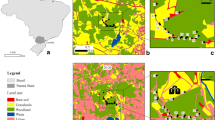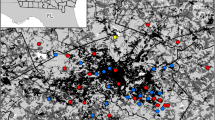Abstract
Urban ecosystems are growing rapidly and urbanization is an important cause of the loss of biodiversity. Bees are declining in abundance worldwide, including urban areas, and this decline is alarming because of their global importance as plant pollinators. Here we examine that decline by comparing a bee assemblage sampled in the 1980s and again in 2015, in an urban area of the city of Curitiba. Both studies sampled assemblages with hand-nets every two weeks during one year of study. Bee species richness has declined by 45% (112 species then, 63 today). Two species that have disappeared, Gaesischia fulgurans (Holmberg, 1903) and Thectochlora basiatra (Strand, 1910), have also disappeared elsewhere in the city. Also, relative abundances of species have changed, notably with the increase of social bees. Large bees that nest in cavities have also increased relative to small bees that nest in the ground. These findings are similar with previous reports indicating the sensibility of bees to urbanization. The increase in paved areas, in urban population and in exotic plants are all probably responsible for the sharp decline in bee diversity and abundance.



Similar content being viewed by others
References
Ahrné K (2008) Local management and landscape effects on diversity of bees, wasps and birds in urban green areas. Acta Uni Agric Suec Agrar 41:1652–6880
Aronson MFJ, La Sorte FA, Nilon CH, Katti M, Goddard MA, Lepczyk CA, Warren PS, Williams NSG, Cilliers S, Clarckson B, Dobbs C, Dolan R, Heldblom M, Klotz S, Louwe Koojimans J, Kühn I, MacGregor-Fors I, McDonnell M, Mörtberg U, Pyšek P, Siebert S, Sushinsky J, Werner P, Winter M (2014) A global analysis of the impacts of urbanization on bird and plant diversity reveals key anthropogenic drivers. Proc R Soc B-Biol Sci 281:20133330
Bates AJ, Sadler JP, Fairbrass AJ, Falk SJ, Hale JD, Matthews TJ (2011) Changing bee and hoverfly pollinator assemblages along an urban-rural gradient. PLoS One 6(8):e23459. https://doi.org/10.1371/journal.pone.0023459
Blüthgen N, Klein A (2011) Functional complementarity and specialization: the role of biodiversity in plant-pollinator interactions. Bas Appl Ecol 12:282–291
Cane JH (2001) Habitat fragmentation and native bees: a premature verdict? Conserv Ecol 5:3
Cane JH (2005) Bees, pollination, and the challenges of sprawl. In: Johnson EA, Klemens MW (eds) Nature in fragments: the legacy of sprawl. Columbia University Press, New York, pp 109–124 382 pp
Cane JH, Minckley RL, Kervin L, Roulston TH (2006) Complex responses within a desert bee guild (Hymenoptera: Apiformes) to urban habitat fragmentation. Ecol Appl 16:632–644
Carvalheiro LG, Kunin WE, Keil P, Aguirre-gutierrez W, Ellis N, Fox R, Groom Q, Hennekens S, Landuyt WV, Maes D, Meutter FV, Rasmont P, Ode B, Potts SG, Reemer M, Roberts SPM, Schaminee J, Wallisdevries MF, Biesmeijer JC (2013) Species richness declines and biotic homogenization have slowed down for NW-European pollinators and plants. Ecol Lett 16:870–878
Cure JR, Laroca S (2010) Comunidade de abelhas silvestres (Anthophila) do Parque da Cidade (Curitiba, Brasil): diversidade, abundância relativa, fenologia e recursos tróficos. Acta Biol Par 39:111–181
Dauber J, Hirsch M, Simmering D, Waldhardt R, Otte A, Wolters V (2003) Landascape structure as an indicator of biodiversity: matrix effects on species richness. Agric Ecosyst Environ 98:321–329
Dormann CF, Gruber B, Fruend J (2008) Introducing the bipartite package: Analysing ecological networks. R news 8(2):8–11
Eremeeva NI, Sushchev DV (2005) Structural changes in the fauna of pollinating insects in urban landscapes. Russ J Ecol 36:259–265
Fain A, Engel MS, Flechtmann CHW, OConnor BM (1999) A new genus and species of acaridae (Acari) phoretic on Thectochlora alaris (Hymenoptera: Halictidae: Augochlorini) from South America. Int J Acarol 25(3):163–172. https://doi.org/10.1080/01647959908684149
Fetridge ED, Ascher JS, Langellotto GA (2008) The bee fauna of residential gardens in a suburb of New York City (Hymenoptera: Apoidea). Ann Entomol Soc Am 101:1067–1077
Fortel L, Henryl M, Guilbaud L, Guirao AL, Kuhlmann M, Mouret H, Rolin O, Vaissie BE (2014) Decreasing abundance, increasing diversity and changing structure of the wild bee community (Hymenoptera: Anthophila) along an urbanization gradient. PLOS ONE 9(8):e104679. https://doi.org/10.1371/journal.pone.0104679
Fragkias M, Lobo J, Strumsky D, Seto KC (2013) Does size matter? Scaling of CO2 emissions and US urban areas. PLoS One 8:e64727
Greenleaf SS, Williams NM, Winfree R, Kremen C (2007) Bee foraging ranges and their relationship to body size. Oecologia 153:589–596. https://doi.org/10.1007/s00442-007-0752-9
Hall DM, Camilo GR, Tonietto RK, Ollerton J, Ahrné K, Arduser M, Ascher JS, Baldock KC, Fowler R, Frankie G, Goulson D, Gunnarsson B, Hanley ME, Jackson JI, Langellotto, G, Lowenstein D, Minor ES, Philpott SM, Potts SG, Sirohi MH, Spevak EM, Stone GN. Threlfall CG‘1 (2017), The city as a refuge for insect pollinators. Conserv Biol, 31: 24–29. doi:https://doi.org/10.1111/cobi.12840
Hansen AJ, Knight RL, Marzluff JM, Powell S, Brown K, Gude PH, Jones K (2005) Effects of exurban development on biodiversity: patterns, mechanisms, and research needs. Ecol Appl 15:1893–1905
Hernandez JL, Frankie GW, Thorp RW (2009) Ecology of urban bees: a review of current knowledge and directions for future study. Cities Environ 2: article 3, 15 pp. http://escholarship.bc.edu/cate/vol2/iss1/3
Hsieh TC, Ma KH, Chao A. 2016 Package ‘iNEXT’. Interpolation and Extrapolation for Species Diversity. http://chao.stat.nthu.edu.tw/blog/software-download/. 2016
Klimov PB, Vinson SB, OConnor BM (2007) Acarinaria in associations of apid bees (Hymenoptera) and chaetocactylid mites (Acari). Invertebr Syst 21:109–136
Kowarik I (2011) Novel urban ecosystems, biodiversity, and conservation. Environ Pollut 159:1974–1983
Maebe K, Golsteyn L, Nuner-Silva P, Blochtein B, Smagghe G (2018) Temporal changes in genetic variability in three bumblebee species from Rio Grande do Sul, South Brazil. Apidologie 49:415–429. https://doi.org/10.1007/s13592-018-0567-1
Martins AC, Melo GAR (2009) Has the bumblebee Bombus bellicosus gone extinct in the northern portion of its distribution range in Brazil? J Insect Conserv 14:207–210
Martins AC, Gonçalves RB, Melo GAR (2013) Changes in wild bee fauna of a grassland in Brazil reveal negative effects associated with growing urbanization during the last 40 years. Zoologia 30:157–176
Martins AC, Silva DP, Marco P, Melo GAR (2014) Species conservation under future climate change: the case of Bombus bellicosus, a potentially threatened south American bumblebee species. J Insect Conserv 19:33–43. https://doi.org/10.1007/s10841-014-9740-7
Matteson KC (2007) Diversity and conservation of insects in urban gardens: theoretical and applied implications. PhD Dissertation, Fordham University. 227 pp.
Matteson KC, Ascher JS, Langellotto GA (2008) Bee richness and abundance in New York Cityurban gardens. Ann Entomol Soc Am 101:140–150
Matthies SA, Ruter S, Schaarschmidt P, Rasse R (2017) Determinants of species richness within and across taxonomic groups in urban green spaces. Urban Ecosyst 20:897–909. https://doi.org/10.1007/s11252-017-0642-9
McIntyre NE, Hostetler ME (2001) Effects of urban land use on pollinator (Hymenoptera:Apoidea) communities in a desert metropolis. Bas Appl Ecol 2:209–218. https://doi.org/10.1017/S0007485317000153
Michener CD (2007) The bees of the world, 2nd Edn. The Johns Hopkins University Press, Baltimore, 953 pp., + 20 pls
Moure JS, Urban D, Melo GAR (2012). Catalogue of Bees (Hymenoptera, Apoidea) in the Neotropical Region - online version. Available at http://www.moure.cria.org.br/catalogue. Accessed 01 Jun 2018
Neff JL, Simpson BB (1993) Bees, pollination systems and plant diversity. In: LaSalle J, Gauld ID (eds) Hymenoptera and biodiversity. CAB International, Wallingford, pp 143–168
Normandin E, Vereecken NJ, Buddle CM, Fournier V (2017) Taxonomic and functional trait diversity of wild bees in different urban settings. Peer J. https://doi.org/10.7717/peerj.3051
Pager JR RE, Scheiner R, Erber J, Amdam, GV (2006) The development and evolution of division of labor and foraging specialization in a social insect (Apis mellifera L.). Curr Top Dev Biol 74:253–286
Plascencia M, Philpott SM (2017) Floral abundance, richness, and spatial distribution drive urban garden bee communities. Bull Entomol Res 107:658–667
Potts SG, Biesmeijer JC, Kremen C, Neumann P, Schweiger O, Kunin WE (2010) Global pollinator declines: trends, impacts and drivers. Trends Ecol Evol 25:345–353
R Development Core Team (2016) A language and environment for statistical computing. R Foundation for Statistical Computing, Vienna, Austria. ISBN 3-900051-07-0, URL http://www.R-project.org
Sakagami SF, Laroca S, Moure JS (1967) Wild bees biocenotics in São José dos Pinhais (Pr), South Brazil - preliminary report. J Fac Sci Hokkaido Univ Ser 6 Zool 19:253–291
Sheffield CS, Pindar A, Packer L, Kevan PG (2013) The potential of cleptoparasitic bees as indicator taxa for assessing bee communities. Apidologie 44:501. https://doi.org/10.1007/s13592-013-0200-2
Shochat E, Lerman SB, Anderies JM, Warren PS, Faeth SH, Nilon CH (2010) Invasion, competition, and biodiversity loss in urban ecosystems. Bioscience 60:199–208
Sing K, Wang W, Wan T, Lee P, Li Z, Chen X, Wang Y, Wilson J (2017) Diversity and human perceptions of bees (Hymenoptera: Apoidea) in Southeast Asian megacities. Genome 59:827–839 (2016). https://doi.org/10.1139/gen-2015-0159
Taura HM, Laroca S (2001) A associação de abelhas silvestres de um biótopo urbano de Curitiba (Brasil), com comparações espaço-temporais: abundância relativa, fenologia, diversidade e explotação de recursos (Hymenoptera, Apoidea). Acta Biol Par:35–137
Winfree R, Bartomeus I, Cariveau DP (2011) Native pollinators in anthropogenic habitats. Annu Rev Ecol Evol Syst 42:1–22
Zanette LRS, Martins RP, Ribeiro SP (2005) Effects of urbanization on Neotropical wasp and bee assemblages in a Brazilian metropolis. Landsc Urban Plan 71:105–121
Acknowledgments
We would like to thank Gabriel Melo for identification of the Megachilini bees and José Tadeu Weidlich Motta for plant identification. We also acknowledge the Brazilian Conselho Nacional de Pesquisa e Desenvolvimento for scholarships to both authors. James J. Roper translated this text from the original Portuguese, and offered comments to improve the manuscript.
Author information
Authors and Affiliations
Corresponding author
Electronic supplementary material
Fig. S1
(PNG 2976 kb)
Table S1
List of bee species found in the Campus Jardim Botânico, Curitiba, Brazil. Morphospecies are indicated by letters for the collection in 1981 and numbers for the collection in 2015 (following Martins et al. 2013). (XLS 52 kb)
Table S2
Plant – bee matrix for 1981 assemblage Campus Jardim Botânico, Curitiba, Brazil. (XLS 296 kb)
Table S3
Plant – bee matrix for 1981 assemblage Campus Jardim Botânico, Curitiba, Brazil. (XLS 102 kb)
Rights and permissions
About this article
Cite this article
Cardoso, M.C., Gonçalves, R.B. Reduction by half: the impact on bees of 34 years of urbanization. Urban Ecosyst 21, 943–949 (2018). https://doi.org/10.1007/s11252-018-0773-7
Published:
Issue Date:
DOI: https://doi.org/10.1007/s11252-018-0773-7




